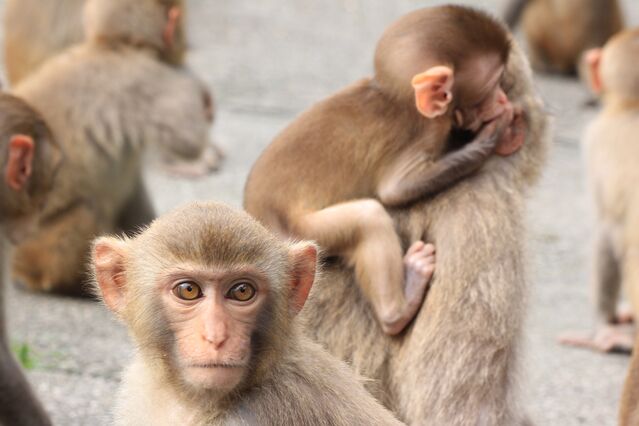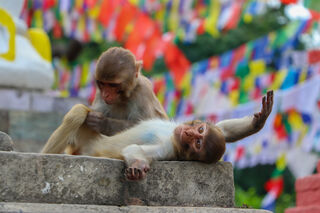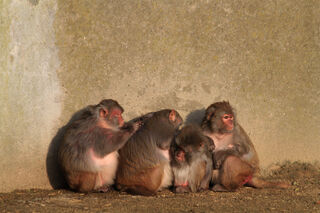Relationships
The Social Brains of Primates
Number of social connections predicts the volume of brain structures in monkeys.
Posted April 25, 2022 Reviewed by Michelle Quirk
Key points
- Researchers found that social connections influence the brain structure of free-ranging rhesus macaques.
- The number of grooming partners predicted the size of neocortical brain areas associated with social decision-making and empathy.
- There was no link between brain structure and other social variables such as social status or indirect connectedness.

Primates, humans included, are known for their complex societies and sophisticated social cognition. Navigating relationships not only depends on recognizing and responding to individuals appropriately but also requires cognitively demanding skills such as knowing about the relationships between others and using that knowledge to make decisions.
Additionally, primate brains are larger relative to body size than the brains of other social mammals. This is especially noticeable in the neocortex, the center for higher brain functions including perception, decision-making, cognition, and language.
Attempting to connect the dots between these two observations—primates are skilled at socializing and have an expanded neocortex—scientists have proposed the social brain hypothesis, which posits that the cognitive demands of living in complex societies has been a key driver in the evolution of large brains.
Support for this hypothesis has come from the relationship, in some animals, between neocortex size and the size of the social group. However, it’s not a perfect correlation, says Camille Testard, a Ph.D. student at the University of Pennsylvania.
“Although group size is one measure that is partially valid, and it’s an easy measure to collect across different species, it’s not the best measure when looking at social complexity and social cognition,” she says.
Sociality in the Wild
In a new study of rhesus macaques, Testard and her colleagues evaluated the social brain hypothesis in a more refined way. First, rather than using group size as a proxy for sociality, the researchers collected detailed data on animals’ social environment. Second, they calculated the size of specific brain structures within the neocortex, instead of looking at overall brain size.
Another novel aspect of the study was the population of research subjects. Brain structure and sociality of rhesus macaques has been studied in laboratory environments for decades. But Testard says relationships in the lab and those in the wild are very different.
“Results you find in the lab don’t necessarily generalize to the wild,” she says. “There is not nearly as much complexity in the social environments of these animals in the laboratory compared to the wild.”

Testard and her colleagues studied a group of free-living macaques on Cayo Santiago Island off Puerto Rico. This colony was established as a research population in 1938 and has been heavily studied ever since.
The researchers recorded detailed interactions of a social group of 68 adult macaques, keeping track of their social status, number of grooming partners, physical distance with other monkeys, connectedness to popular monkeys, and a factor called “betweenness” that measured the ability to act as a bridge between disconnected parts of the social network. The team also collected brain scans from every individual in the social group, from 1-month-old infants to 25-year-old adults.
Relationships on the Brain
Testard and her colleagues’ analyses revealed that in adult macaques, there is a strong relationship between the social network size (i.e., the number of direct relationships they have) and the volume of two connected brain structures—the mid-superior temporal sulcus (mid-STS) and the ventral dysgranular insula (vd-insula).
The macaque mid-STS is a homologue of a region called the temporal-parietal junction in the human brain, meaning the regions have similar anatomy and connections to other brain areas. In humans, neuroimaging work has related activity in this area to the ability to mentalize, or understand someone else’s perspective. In nonhuman primates, recordings of single neurons in the mid-STS show that this area monitors others’ actions and encodes information about social context. The vd-insula, meanwhile, has been connected to empathy in humans and the expression of affiliative behavior in rhesus macaques.

Surprisingly, Testard and her colleagues did not find any associations between brain structure and other social characteristics.
“We know that social status and indirect connectedness are relevant to their lives, and we thought there might be a variation in brain structure related to these aspects of the social environment, but we didn’t find that,” says Testard.
According to the researchers, these results suggest that the direct relationships individuals have to acquire and maintain throughout their lives exert the strongest computational demands on their brains and might be the biggest driver of variation in brain structure.
Finally, the team found that the brain structure of infants (monkeys up to 5 months old, who spend nearly all their time in proximity to their mother) was not predicted by the mother’s social network size or status. Testard says this finding may indicate that the relationship between sociality and brain structure arises later in development when individuals directly interact with their social environments.
What Good Is a Social Life?
The researchers say that these findings may be applicable to other primate species, including humans.
“Studying these brain areas may reveal the neural code underlying our ability to socialize and lead to ways to improve that ability in individuals with difficulties socializing,” says Testard.

In future studies, Testard wants to investigate the potential biological impact of one’s social relationships. The behavioral data and brain scans from this population of macaques came from before 2017, when Hurricane Maria devastated Puerto Rico and the small island these monkeys call home. Last year, Testard and colleagues published a study on the social interactions of these macaques before and after the hurricane.
“Following this event, even though there were fewer resources on the island, we found that the monkeys expanded their social networks to include more partners, were more socially tolerant of each other, and exhibited less aggression,” she says.
Now, Testard wants to compare brain scans of these monkeys from before and after Hurricane Maria.
“I’m interested in what advantage social relationships can give individuals and how they might help us cope with our environment,” she says. “We have the data to look at the impact of this catastrophic event on brain structure. We can ask whether those social relationships that monkeys invested in following the hurricane protect the animals from the disaster’s impact in any way.”
References
Testard C, Brent LJN, Andersson J, Chiou KL, Negron-Del Valle JE, Decasien AR, Acevedo-Ithier A, Stock MK, Anton SC, et al. 2022. Social connections predict brain structure in a multidimensional free-ranging primate society. Science Advances 8(15). Doi: 10.1126/sciadv.abl5794.




